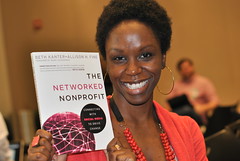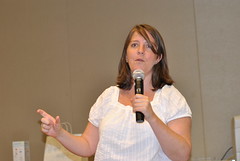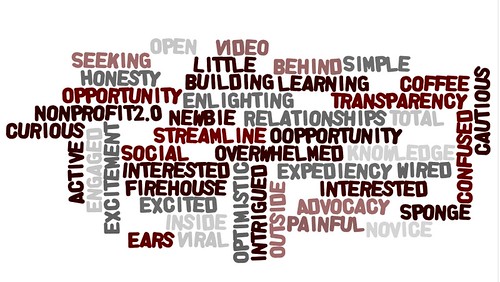
I attend a lot of conferences, but mostly as a keynote speaker, workshop leader, or panelist. I don’t often get a chance to listen and learn. That was the gift of attending Nonprofit 2.0 Conference, especially the “unconference sessions” in Washington, DC on Friday. A big thank you conference organizers!

We kicked off the conference with an interview style keynote about the Networked Nonprofit, moderated by fabulous Shireen Mitchell (aka digitalsista). The best part is when the audience joins the conversation. Shireen did a fabulous job of bringing in their voices.

Many in the audience were colleagues that I have met through my blog over years and have helped me with Cambodian fundraising, like Roger Carr. Rosetta Thurman, who writes about nonprofits and leadership issues from a Gen Y blogger perspective, shared some thoughts about the generations, nonprofits, and social media. Her blog is a must-read and I hope someday that she writes a book.

Wendy Harman from the Red Cross was the next keynote. Wendy has let me shadow her work for the past five years and share her wisdom in many blog posts. She shared some insights about the Red Cross’s social media work leading up to Haiti.
She made great points about what they had in place the day before the earthquake in Haiti struck:
- Robust listening program where staff skims and responds. Over 1,000 mentions a day. This gives the capacity to pay attention to what people are saying and be nimble in responding.
- They do not view social media as fundraising strategy. The objective is to empower to stakeholders to make their mission to be more efficient.
- They have a social media policy and handbook that provides the rule book for volunteers, staff, and affiliates to participate on social media channels effectively.
- Wendy has been working an internal social media capacity builder. She trains, coaches, and evangelizes internally on how to use social media. She has also been training staff in the disaster response department who in turn used tools like Twitter on the ground from Haiti.
- They had social content. It’s a mix of serious and fun content. When not in a disaster, you might see LOLcats doing CPR.
- A lot of practice on how to move quickly when a disaster strikes. For example, they immediately start updating their Facebook page letting people know what information is available and they are there.
Wendy’s keynote drove two points home for me:
Don’t give up in the middle: Many nonprofits embrace social media with over-inflated expectations. They get midway through an experiment, view it as a failure and give up. Everything looks like a failure in the middle as Rosabeth Moss Kanter likes to say. Don’t give up!
Networks Ebb and Flow Like the Ocean: Networks have different stages of development and functioning. And they ebb and flow according to need. If you’ve built your network, like the Red Cross, they will be there for you.
I participated in two unconference sessions. Here are my notes.
I’ve Found My Free Agents, Now What?
Here’s a couple of takeaways, but expect some more practical, how-to posts in the next few weeks.
- Look for Free Agents who already know about your work. Look to your in-house lists for potential free agents. They may already know about you and just need to be empowered. Care2 has a social media tracker tool that can analyze your list to see who is on social networks and how many friends.
- Scan Social Networks for Free Agents. I shared some of my special sauce about how I identify free agents as well as from my perspective of being one. There are Free Agents with huge networks like Shawn Admed, but don’t over look those that may have smaller networks – they’re just as valuable.
- Getting to Know and Cultivating Free Agents: Here’s my best advice on this. It comes down to do a little bit everyday and treating people like people.

Listening in Practice
Wendy Harman was the inspiration for workshop curriculum on social media listening skills. So we offered to co-lead a session on listening in practice. Wendy is a real team player and made the session a lot of fun! We explored people’s listening routines, perceptions about the value of listening, and specific tools and techniques.
Listening to the participants in our session talk about listening, I realized there are three different models:
Actionable Listening: This is the first step that many nonprofits take for listening. When social media isn’t successful, it is because they skipped this. This is the type of listening akin to changing a flat tire on a moving car. It’s very practical and used to identify influencers, new ideas, and monitor brand. You can set up a comprehensive listening post or do “quick and dirty” simply set up one alert on your organization’s name. No matter the approach, it is useful to have a structured approach and track trends over time.
Forensic Listening: Chris Abraham shared this method and is primarily for those who haven’t yet started. This approach, uses tools like SM2 to do a content scan during a particular past time period. Think of it as another channel of research for campaign.
Showing Results: This method is for those have been applying listening techniques and want to track results. One metric that is used is “Share of Conversation” or how much people are talking about your brand. One method is to compare before/after a campaign to determine how much conversation social media strategy has been generated.
Thank you Geoff, Allyson, and Shireen for organizing an inspiring conference!
